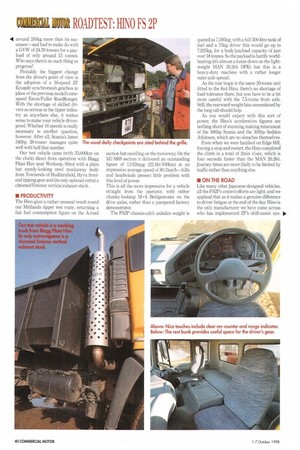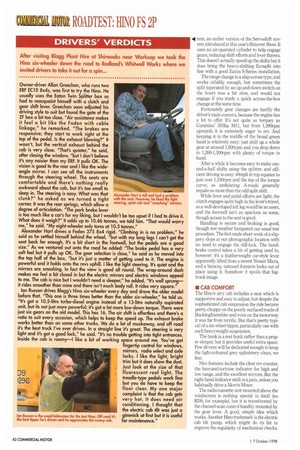FAST& FRUGAL
Page 40

Page 42

Page 44

Page 45

Page 43

If you've noticed an error in this article please click here to report it so we can fix it.
Hino tippers have a reputation for rugged dependability that is likely to be maintained by the FS2P LKD six-wheeler. The weight of that bulletproof chassis takes its toll on payload, but with 320hp on tap this one's a real flier and a pleasure to drive.
There's a lot to be said for simplicity. In this age of specialisation and optimisation, it's refreshing to come across a product which doesn't claim to be the king of a very small hill, but aims to be a good allrounder. Hino's FS2P six-wheeler is one of these: a sturdy, powerful 26-tonner with something for everyone.
To be honest a Hino has to offer something for everyone as importer Harris (UK) doesn't give you much choice—it offers just one level of cab specification, one driveline and one wheelbase. And, in most respects, you get a lot for your money.
• PRODUCT PROFILE If you root around in the spec sheet you can „ find a couple of other variants of the FS2P: the
"1 LIN is a mixer chassis with the same wheelbase, which weighs 415kg more than the tipper; while the TKA is a Japanese-style 6x4 distribution hassis with an outer axle spread of 6.25m and a chassis weight of around 8.5
tonnes. We won't be seeing too many of those 1 • 9 in the UK.
But the FS2P LKD tipper has a certain presence of its own, thanks to its underpinnings: the complete driveline from its 8x4 stablemate, the FY2P UKA This includes a 10.5-litre engine rated at 320hp mated to ZF's 16-speed Ecosplit synchromesh gearbox. Combined with the rear bogie from the 32-tonner it makes for a notably heavy-duty package—in both senses of the word.
The new Hino's cab is also shared with the eight-wheeler, and comes complete with a rest bunk, so the six-wheeler's unladen weight is nothing special, but it's likely to appeal to muckaway operators who need durability above everything else.
Just look at the size of the diff housings, for instance: they're massive enough to be the main constraint on ground clearance (the brake chambers are tucked neatly away) but Stuart Barlow of Trucks Morley, the dealer who supplied this example, claims convincingly never to have seen the inside of one.
Mind you, the FS2P is not as massive as one of its predecessors: the FY271 six-wheeler we tested in 1989 had a thumping great naturally aspirated 13-litre diesel rated at just 243hp (181kW). That unit delivered a mere 849Km of torque (40% down on the FS2P) but the chassis-cab weighed in at a mighty 8,273kg • around 350kg more than its successor—and had to make do with a GVW of 24.39 tonnes for a payload of only around 15 tonnes. Who says there's no such thing as progress?
Probably the biggest change from the driver's point of view is the adoption of a 16-speed ZF Ecosplit synchromesh gearbox in place of the previous model's ninespeed Eaton/Fuller RoadRanger. With the shortage of skilled drivers as serious in the tipper industry as anywhere else, it makes sense to make your vehicle driverproof. Whether 16 speeds is really necessary is another question, however. After all, Scania's latest 340hp 38-tonner manages quite well with half that number.
Our test vehicle came (with 23,000km on the clock) direct from operation with Blagg Plant Hire near Worksop, fitted with a plain but sturdy-looking steel muckaway body from Townends of Huddersfield, Hyva frontend tipping gear and (its only optional extra) a chromed Eminox vertical exhaust stack.
• PRODUCTIVITY The Hino gave a rather unusual result round our Midlands tipper test route, returning a fair fuel consumption figure on the A-road
section but excelling on the motorway. On the MI/M69 section it delivered an outstanding figure of 12.62mpg (22.41it/100km) at an impressive average speed of 80.1km/h—hills and headwinds present little problem with this level of power.
This is all the more impressive for a vehicle straight from the operator, with rather chunky-looking M+S Bridgestones on the drive axles, rather than a pampered factory demonstrator.
The FS2P chassis-cab's unladen weight is quoted as 7,5951%; with a full 300-litre tank of fuel and a 75kg driver this would go up to 7,9251%, for a body/payload capacity of just over 18 tonnes. So the payload is hardly worldbeating (it's almost a tonne down on the lightweight MAN 26.264 DFIC) but this is a heavy-duty machine with a rather longer outer axle spread.
As the rear bogie is the same 20-tonne unit fitted to the 8x4 1lino, there's no shortage of load tolerance there, but you have to be a bit more careful with the 7.5-tonne front axle. Still, the rearward weight bias necessitated by the long cab should help.
As you would expect with this sort of power. the Hino's acceleration figures are nothing short of stunning, making mincemeat of the 306hp Scania and the 305hp Seddon Atkinson, which are no slouches themselves.
Even when we were baulked on Edge Hill, forcing a stop and restart, the Hino completed the climb in a total of 2min 41sec, which is four seconds faster than the MAN 26.264. Journey times are more likely to be limited by traffic rather than anything else.
• ON THE ROAD Like many other Japanese-designed vehicles, all the FS2P's control efforts are light, and we applaud that as it makes a genuine difference to driver fatigue at the end of the day. Hino is the only manufacturer we have come across who has implemented ZF's shift-assist sys 4 tem; an earlier version of the Servoshift system introduced at this year's Hanover Show. It uses an air-operated cylinder to help engage gears, reducing shift efforts and lever throws. This doesn't actually speed up the shifts but it does bring the heavy-shifting Ecosplit into line with a good Eaton S-Series installation.
The range change is a slap-across type, and works reliably enough, but sometimes the split (operated by an up-and-down switch on the lever) was a bit slow, and would not engage if you made a quick across-the-box change at the same time.
Fortunately gear changes are hardly the driver's main concern, because the engine has a lot to offer. It's not quite as torquey as Cummins' 305hp M11, but from 1,200rpm upwards it is extremely eager to rev. And keeping it in the middle of the broad green band is relatively easy: just shift up a whole gear at around 1,600rpm and you drop down to 1,200-1,300rpm with plenty of torque in hand.
After a while it becomes easy to make oneand-a-half shifts using the splitter, and effident driving is easy: 40mph in top equates to just over 1,100rpm and the top of the torque curve, so undulating A-roads generally require no more than the odd split shift.
While lever and pedal efforts are light, the clutch engages quite high in the lever's travel, so a well-developed left leg would be an asset, and the footwell isn't as spacious as some, though access to the seat is good.
Handling is secure and braking is good, though wet weather hampered our usual test procedure. The 6x4 made short work of a slippery slope at our photographic location with no need to engage the diff-lock. The handbrake control takes a bit of getting used to, however: it's a featherweight car-style lever apparently lifted from a recent Nissan Micra, and a brawny, tattooed forearm looks out of place using it. Somehow it spoils that bigtruck image.
• CAB COMFORT The Hino's airy cab includes a seat which is supportive and easy to adjust, but despite the sophisticated cab suspension the ride became pretty choppy on the poorly surfaced roads of Buckinghamshire and even on the motorway it was far from terrific. But that's pretty typical of a six-wheel tipper, particularly one with such heavyweight suspension.
The bunk is a rest bunk rather than a proper sleeper, but it provides useful extra space. Few drivers will be dedicated enough to keep the light-coloured grey upholstery clean, we fear.
Nice features include the clear rev-counter, the hare-and-tortoise indicator for high and low range, and the excellent mirrors. But the right-hand indicator stalk is a pain, unless you habitually drive a Morris Minor.
The radio/cassette unit mounted above the windscreen is nothing special in itself (no RDS, for example), but it is transformed by the channel-scan control handily mounted by the gear lever. A good, simple idea which works. Another Hino trademark is the electric cab tilt pump, which might do its bit to improve the regularity of mechanical checks. The cab has remote central locking as a standard feature too. As we've asked a hundred times before, why don't all modern trucks have this? And of course the cab incorporates Hino's trademark interior light; a phenomenally bright fluorescent unit that can ruin your night vision for weeks...
• SUMMARY The word that comes to mind when driving the Hino is purposeful. This tipper has a lot to offer in a straightforward package: power, robustness, a fair degree of comfort and pretty good fuel economy.
True, you can specify a much lighter truck and, with careful driving, you might get a more economical truck, but the FS2P is easy to drive and easy to buy.
The clincher is likely to be your local Hino dealer-if you've got one, that is. Hino's onagain/off-again relationship with the UK truck market seems to have stabifised, but many operators are cautious by nature and will take some convincing that the brand is here to stay. Judging by the product itself, Hino should be here for the long haul.
by Toby Clark Many thanks to Blagg Plant Hire of Shireoaks (01909 500296) for the use of the Hino.
Price as tested: £56,950 (ex-VAT), chassis-cab only. Engine: 10.5 litres, 320hp (239kW). 26 tonnes. Body/payload: 18.08 tonnes.
Fuel consumption: 9.48mpg (29.81it/100km). Average speed: 64.6km/h (40.1mph).
SPECIFICATION
ESSIMI Nino F52P LICID rest cab 6rA tipper..
Design GVW: 26 tonnes.
Plated GVW: 26 tonnes.
Importer: Norris (UK), Gatherley Rood Industrial Estate, Brompton-on-Swale, Ridimond, North Yorkshire DL10 7.1Q
DIMES Nino P11 C-It fourslroke, charge-cooled DI diesel.
Cylinders: Six, in line.
Compression ratio: 16:1.
Bare/stroke: 122x150mm.
Capacity: 10.52 litres.
Maximum net power= 325hpl239kW) at 2,050rpm (to EEC 88/195).
Maximum net torque: 1,411Nm 11,0801bftlat 1,10Orpm to EEC 88/1951. 2F Ecosplit 165151 16-speed synchromesh with shift assist Final drive: 4.10.1.
Clutch: Dry, twin plate with damper springs, oir-assisted hydraulic actuation.
TRANSMISSION
Drum brakes, full-air, Nro-line system with load sensing valve on driven axles. Parking: Spring brake, acting on front and centre axles. Exhaust: Electra-pneumatic with valve in exhaust downpipe
BRAKINC1'6?".;TEM-S.
MEE • Recirculating ball with integral hydraulic booster and additional boost ram.
C 11 AS S IS ladder-shaped chassis with U-frome. Suspension: Front, semi elliptic leaf springs with anti-roll bar and single acting hydraulic damper; rear, semi-elliptic leaf springs with torque rods.
Axle design weights: Front, 7.5 tonnes; rear bogie, 20 tonnes. Wheels and tyres: ISO 10-stud 22.5 x 8.5 disc wheels with 165mm offset, front tyres, 315/80 R22.5, rear tyres, 11R 22.5. Fuel tank: 300 litres.
ELECTRICAISYSTEMS: Batteries: 2x1 2V in series, 150Ah. Alternator: 24V, 50A Os WAR F. ANTY Two years; second year covers
driveline only.
DEALERS AND STRODE p011,115 Nino has eight dealers in the UK OPERATIONAL TRIAL RESULTS
Motorway1105.4 km/65.5 miles): Average speed, 80.1km/h; fuel consumption, 12.62mpg (22.414/100km). A-roads (1 57.2km/97.7 miles): Average speed, 57.2km/h; fuel consumption, 8.13mpg (34.71it/100km).
Overall 1262.6 km/163.2 miles): Average speed, 64.6km/h; fuel consumption, 9.48mpg (29.814/100km).
HILL PERFORMANCE
Edge Hill 2min 41sec* • See text.
ACCELERATION
km/h sec
0-80 42.9 32-64 18.9 48-80 25.2 IN-CAB NOISE km/h dB(A) Tickover 51.4 48 62.4 64 63.9 80 69.3 85 71.1 Figures from earlier 8x4 test; see text. WEIGHTS Chassis-cab kerbweight with a full load of fuel and 75kg driver 7,925kg Tipping body system 2,535kg Net payload 15,540kg Total 26,000kg
















































































































